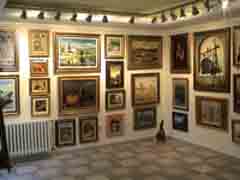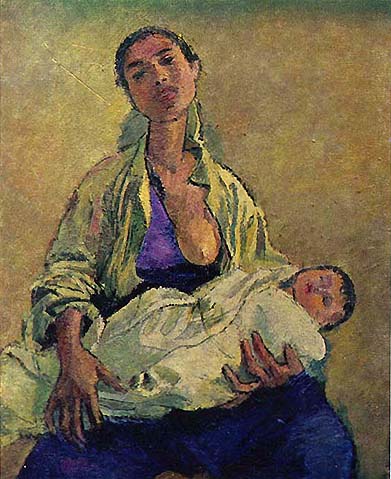Bukefal gallery Skopje
  The creative work of Macedonian artists can be followed with continuity since the early 18th century. Siljan from the village of Tresonce inscribed his name on an icon in the Church of the Assumption of the Holy Virgin in Veles in the year he painted the icon, 1725. From that time until 1880, when the first paintings were made by Dimitar Andonov Papradiski, abandoning established formulae of church art, a number of exceptional artists emerged in Macedonia, and their works sum up an entire period of church painting. The creative work of Macedonian artists can be followed with continuity since the early 18th century. Siljan from the village of Tresonce inscribed his name on an icon in the Church of the Assumption of the Holy Virgin in Veles in the year he painted the icon, 1725. From that time until 1880, when the first paintings were made by Dimitar Andonov Papradiski, abandoning established formulae of church art, a number of exceptional artists emerged in Macedonia, and their works sum up an entire period of church painting.
The most distinguished among them were Trpe Zograph, who painted the tomb chapel of St. Naum in the Monastery of St. Naum; Teodosij Zograph, born in Veles, who painted the Church of the Assumption of the Holy Virgin in Novo Selo near Stip and the painting "The Readily Assistant Mother of God" in 1828, depicting his self-portrait and the portraits of his wife and son.
At that time, several zographs worked in Veles, including Krste Pop Trajanovic, Damjan Jankulov and his son Gjorgi Jankulov, and other minor zographs. In the beginning of the 19th century, a group of zographs from Albania arrived in Macedonia, including the well-known Mihailo and his sons Dimitrija and Nikola. They decorated the men's refectory of the Monastery of St. John of Bigor with frescoes, and painted the iconostasis of the monastery church (1830-33). In 1946, zograph Gjorgi and his son Manuil from Kostur [Castoria, Greece] painted the iconostasis in the Church of St. Demetrius in Bitola, and somewhat later, Manuil frescoed the Church of the Large Holy Anargyroi (the Holy Healers) in Ohrid.
All zographs who worked in Macedonia in the second half of the 19th century were of Macedonian origin. The most distinguished among them was Dico Zograph (Dimitar Krstev) from the Debar village of Tresonce. He painted frescoes in a number of churches in western Macedonia between 1848 and 1852, including the frescoes in the monastery church of St. John of Bigor and the Church of St. George the Triumphant in the village of Rajcica. He also worked on the iconostasis and the paintings of the Church of St. Nicholas Gerakomia in Ohrid from 1862 to 1869.
Among the numerous Macedonian zographs of the second half of the 19th century renowned are the names of Blagoj Damjanov from Tresonce and his sons Mihail and Hristo, the zographs of the Frckovski family, Hristo Makriev, Kuzman Blazenov and his son Janko, and Danil Nestorov.
Dimitar Papradiski abandoned the standards of church painting and turned to secular themes. In addition to a considerable number of icons and mural compositions, Papradiski left behind numerous portraits, landscapes, and paintings with patriotic motifs. Younger Georgi Zografski was a notable figurative painter, who left behind a number of portraits.
The foundations of contemporary and modern Macedonian visual art were laid by several painters in the 1930s, educated in European visual art centers and specialising in European art themes. Among them were Dimitar Pandilov-Avramovski, Lazar Licenovski, Nikola Martinovski, Vangel Kodzoman, Tome Vladimirski, Ljubomir Belogaski, Vasilie Popovic-Cico, Kiril Karadza, Dimce Koco, and Borko Lazeski.

Painting by Nikola Martinovski
In 1945, immediately after World War II, the School of Art was opened in Skopje. The following year, the Association of Visual Artists of Macedonia (DLUM) was formed, and the first group exhibition of DLUM members was displayed in Skopje in 1947. An art gallery opened in Skopje in 1949. One year after the disastrous earthquake of 1963, the Skopje Museum of Contemporary Art was opened, which, along with several art galleries, played a decisive role in the development of the visual arts in Macedonia.
With the passing of time, the themes connected with the revolution and the rebuilding of the country gave way to universal themes of man and his existence. Younger generations expanded their interest in the possibilities of form and style. Painters like Pece Vidimce, Mile Korubin, Risto Lozanovski, Katja Eftimova, Borislav Trajkovski, Petar Mazev, Spase Kunoski, Toma Sijak, Ljubodrag Marinkovic-Penkin, Ordan Petlevski, Dragutin Avramoski-Gute, Ivan Velkov, Vanco Georgievski, Dimitar Kondovski, Bogoljub Ivkovic, Risto Kalcevski, Trajce Jancevski, and, somewhat later, Rodoljub Anastasov, Vangel Naumovski, and Dusko Stojanovski introduced refined drawing and colourful expression, penetrated the fantastic, erotic, and the subconscious, and created an abundant range of works.
According to art historians, the pronounced interest in tradition and discovery of new relations towards the physical and social environment of Macedonia is characteristic of a large group of outstanding painters who emerged between the 1960s and 1970s: Gligor Cemerski, Aleksandar Risteski, Ilinka Gligorieva, Simeon Semov, Nove Frangovski, Vasko Taskovski, Tanas Lulovski, Nikola Fidanovski, Ana Temkova, Rubens Korubin, Dusan Percinkov, Done Miljanovski, Kole Manev, Pavle Kuzmanovski, Taki Pavlovski, Vladimir Georgievski, Kiril Efremov, Ilija Penusliski, Gjoko Matevski, Zarko Jakimovski, Dimitar Manev, Ilija Kocovski, BIagoja Nikolovski, Ilija Arizanov, and Gligor Stefanov.
The beginnings of contemporary graphic art in Macedonia can be traced to the pre-war wood engravings and linocuts by Vasilie Popovic-Cico, Dimitar Pandilov-Avramovski, Ljubomir Belogaski, Borko Lazeski, and the illustrations by Nikola Martinovski. Following World War II, a large number of young visual artists were solely engaged in graphics, such as Bozin Barutovski, Mence Spirovska, Dragan Bikov, Tomislav Krmov, Dimitar Malidanov, Georgi Culakovski, and Biljana Unkovska.
The appearance of academic sculptor Eftim Andonov was of great significance for sculpture, whereas Dimo Todorovski, according to art historians, is the founder of contemporary Macedonian sculpture. The long list of contemporary Macedonian sculptors would not be complete without the names of Borka Avramova, Jordan Grabulovski, Boro Mitrikeski, Ilija Adzievski, Petar Hadzi Boskov, Tome Serafimovski, Dragan Poposki-Dada, Stefan Manevski, Vasil Vasilev, Naso Bekaroski, Branko Koneski, Aneta Svetieva, Olga Milic, BIagoja Cuskov, Aleksandar Ivanovski-Karadare, Milan Jovanovic, and Nikola Sentevski.
Interior decorating and furniture design has been the occupation of M. Cakelja, L. Kubes, S. Brezovski, G.Georgievski, and D. Sojlevski.
In the field of scenography, the most distinguished names are Vasilie Popovic-Cico, Toma Vladimirski, Branko Kostovski, Dime Sumka, Dimitar Kondovski, and Vladimir Georgievski, while the younger generation includes Krste S. Dzidrov, Valentin Svetozarev, Aleksandar Karadare, and Mustafa Asim. Engaged in textiles and fashion are Rada Petrova-Malkic, Dusko Stojanovski, Elena Patrnogic, Georgi Zdravev, Zorica Todorovska, Elena Donceva, Lira Grabul, Meri Gjorgievska, and BIagoj Micevski. The tapestries of Lazar Licenovski, Dimce Protuger, Dimce Koco, Done Miljanovski, and Slobodan Trajkovski are well known.
In Macedonia, there are a number of outstanding artists engaged in book design, including Niko Tozi, Kosta Bojadzievski, Dimitar Kondovski, MIaden Tunic, Aco Kaevski, Aleksandar Cvetkovski, Konstantin Tancev-Dinka, Koco Fidanovski, and Dimce Isajlovski.
The most distinguished Macedonian art photographers are Blagoj Drnkov, Kiro Bilbilovski, Zivko Janevski, Robert Jaki, and Aleksandar Cvetinovski.
From Macedonia Yesterday and Today by Jovan Pavlovski & Misel Pavlovski (www.mian.com.mk)
Translated by: Zaharija Pavlovska |